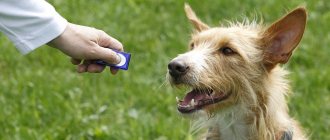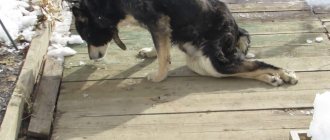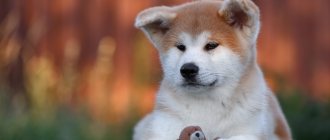The basis of dog education is that the dog sees a pack in the family; if a person does not prove himself to be a strong and confident leader, the dog will take on the specified mission, turning into a teacher and leader. This is where the roots of the pet’s disobedience and aggression come from. It is better to spend time eliminating the rebellion at its roots than to spend a lot of time later unsuccessfully correcting the situation.
Violence against dogs is prohibited.
First of all, you need to remember that raising a dog is not slapping a soft spot, which will not give anything other than causing pain to the pet. By the way, in a pack of dogs they don’t hit each other, so it’s pointless to mindlessly hit an animal. We need to come up with other, more humane ways to raise a ponytail.
How to distinguish training from education?
Experience suggests that there is still a difference. It already slips into the definitions themselves. Training is teaching a dog a set of specific actions that must be performed on a signal from the trainer. And education is learning the laws and rules of life in the surrounding social environment, in other words, learning to communicate and peacefully coexist with other people and dogs. Training skills undoubtedly help in education, but proper training cannot be achieved without some education. So, like everything in the world, these two things are interconnected.
I have met very well-mannered dogs who have not undergone a single training course. And trained, but at the same time completely ill-mannered. And, to be honest, I liked communicating with the former much more than with the latter. Because you don’t know what to expect from these latter ones. The owner may claim that they completed the course, and this is quite possibly true. But does the dog obey his commands? As a rule, no. She behaves as she pleases, and the owner cannot influence her. Many accidents happen to these dogs.
As a rule, owners refuse to educate their dog without any malicious intent. Just “well, he’s such a cute little puppy!” How can you demand anything from him? We love him so much!” This love then goes sideways. For a dog is not a person, it does not understand halftones. She only has black and white, yes or no. And she understands this: if I’m not prohibited from doing something, then it’s okay to do it. If the owner takes this into account, he will avoid many problems in the future.
Rewarding good behavior
Every correct action or reaction must be rewarded. And do not wait for this specific moment, but reward the dog immediately: within a few seconds after the praiseworthy behavior. If the dog has committed an offense and followed the wrong command, there is no need to punish the pet or use physical force. It will be enough if you do not give the animal a treat, toy or other reward.
Your commands for which your dog can be rewarded should be simple and clear. For example, “sit”, “lie down”, “fu”, etc. So that the animal understands why exactly it is being praised. And also, if several family members will train the dog, the reward system should be identical and consistent. For performing the same commands, you need to reward your friend equally. If the gift consists of some kind of delicacy or sweetness, the main thing is not to overfeed. Keep treats to a minimum.
First steps in training
Training is a kind of science, by studying which you will find the answer to the question “How to raise an ideal dog?” Remember that without it the puppy will not be able to become a worthy member of society. There are many ways to train, some of which can be found in the video. But you won’t teach a tiny puppy to commands that are still difficult for him. So where to start?
Meeting the puppy
Raising a puppy begins from the first days of its appearance in the house. Now you are both a parent and a teacher for him. The dog baby doesn’t know anything yet and is not familiar with your household.
As soon as you get home, put your baby on the floor and let him sniff the new territory. He will be scared, but natural curiosity usually overcomes fear and forces the puppy to start exploring everything around. At this time, you should be close to him, talking in a calm voice.
Once your puppy is familiar with his surroundings, squat down to appear smaller and call him. He doesn’t know his name yet, but he will respond to your voice. When the puppy runs up, praise him. If the baby is scared and does not want to approach, then you can lure him with a treat.
After the baby gets comfortable with you, introduce him to your household. At the same time, ask not to make noise - loud noises will scare the puppy.
But it is advisable to get acquainted with other pets on neutral territory or not from the first day the puppy moves into the house. First, accustom the animals to each other’s smell: let an adult dog or cat sniff the baby’s thing and vice versa. After some time, organize a meeting for them under your supervision. Remember, even if an old-timer animal is wary of a new resident, you cannot beat him! This will develop bad relations between them.
Place and toilet training
The key to successful coexistence of a dog and a person in the same apartment is the absence of problems with the toilet. Naturally, at first the puppy will pee wherever he feels like it - it’s difficult for him to control this process. Therefore, it is very important to correctly explain to your baby where to go to the toilet. Use the following method.
For the first time, choose a place for the WC next to the puppy’s bed. Also place several “toilets” in other areas of the apartment. Absorbent diapers are best suited for these purposes. They can be moistened with baby's urine - the smell will help identify the toilet.
In the next video you can learn more about toilet training a puppy.
The key to success in training is your attentiveness and reaction. Observe your puppy after sleeping, feeding, or playing. As soon as he starts sniffing everything around, you need to pick him up and take him to the place prepared for the toilet. When he recovers, praise him. Be patient: some dogs grasp this science on the fly, others will have to be swaddled many times - you cannot beat them for mistakes.
Gradually reduce the number of toilet diapers to one, which you move to the corridor towards the exit. When the baby learns to endure for a long time, it is thrown away, but until 5-6 months there should be a “duty” diaper in the apartment.
Another command that people start learning right away is “Place”. It's easy to learn how to do it correctly. When the puppy has had enough of playing and is tired, take him to the bedding, saying “Place,” put him on the bed and pet him. This is one of the best ways.
To ensure that your puppy grows up healthy and strong, teach him hygiene and veterinary procedures from an early age. Such as bathing, ear cleaning, nail trimming, etc.
We teach you to answer the call
One of the important commands for a dog is “Come to me.” You can easily get used to it while the baby is small. To do this, say the puppy’s name and, when he runs up to you, say “Come to me.” Be sure to praise him and give him a treat. Repeat for a few minutes every day, and turning your practice into a game is a great way to reinforce it.
This video will tell you what a beginner in the world of dog breeding should know about training.
Night cry
At the very beginning of their life together, a puppy weaned from its mother will cry at night. Many dog owners are not prepared for whining and, in order to calm the dog down, they take it to bed with them. If you don't want your dog to sleep with you always, then don't do it! The best way is to move the baby's bedding closer to the bed and lower your hand towards him. This way he will feel your warmth and will not be lonely.
By the way, in no video you will find a demonstration of training a puppy to sleep alone.
"Bite" to explain something
Until you became its owner, the dog was commanded by the mother. To deal with a disobedient child, the animal world has its own way: the mother bites the puppy in the neck or simply rolls it onto its back.
A person can also use these same methods, but to imitate a bite, you need to tense your fingers and simply hit the neck with the tips, but only from above, where the skin is rougher.
If the behavior has not changed, then throw the naughty person on his back. It is possible that the pet will not understand the first time, but by the third time he will definitely realize that he is to blame.
Don't yell at them if they did something bad
If you leave your puppy in a crate and come home and it's dirty, resist the urge to stick your puppy's nose in the dirt or yell at him.
Your puppy won't associate the punishment with the act of soiling because you didn't catch him in the act. Yelling at your puppy may have the opposite effect of training the puppy - it may start urinating submissively to prove to you that it is not a threat.
They may also develop neurotic behavior such as hiding or even eating their own feces to avoid punishment.
iStock/Getty Images Plus
Raising a puppy. Where to start and how to succeed
As soon as a puppy appears in your home, he immediately becomes an object of attention and admiration for the whole family. He is pampered, touched by small pranks, chewed slippers and broken flowers are forgiven. Meanwhile, the dog lays the foundations for incorrect behavior and forms bad habits that will not be so easy to eradicate. A wise owner knows how important it is to start training a dog in a timely manner. This is a continuous process, often difficult, but very interesting.
Where to start raising a puppy? How to do this correctly?
From the very first hours of being in the house, the dog should feel the friendly attitude of the people around it. Often a small puppy, cut off from its canine family, feels defenseless and lonely in a new environment. The dog is a pack animal that understands and respects pack discipline. Therefore, the dog owner needs to try to become the leader of this conditional pack.
From the very first days, explain to the puppy what is allowed to do and what is not. Your requirements must be understandable to the animal—specific and consistent. Associate the puppy's correct actions with pleasant sensations for him.
And, conversely, the pet’s unwanted actions should be associated with unpleasant experiences. Bad behavior cannot be ignored. At the same time, remember that no matter how smart your four-legged friend is, he is still just a dog, so you should not demand from him too subtle an understanding of human emotions, to be offended, jealous, or shame. Do not make your puppy suffer from unfounded and incomprehensible reproaches.
At what age should you start training a puppy?
The earlier the better. The main thing is not to overload it too much, since at an early age it is difficult for a dog to concentrate and quickly gets bored of studying. Do small training sessions of five minutes each and try to keep them fun and play-like for your puppy.
First of all, teach your pet to respond to its name. Call your puppy for feeding or while walking. You can gradually learn the command “come to me” . At the same time, try to keep the tone of your voice calm and friendly.
Starting from the age of two months, teach the puppy the command “no” (or “fu” ). It should be said in a low, sharp voice, but under no circumstances should you shout, otherwise you may frighten and disorient the animal.
If you live in a city, then you need to teach your dog to walk on a leash as early as possible. First, try wearing a collar occasionally and, as soon as you understand that your pet is calm about it, fasten the leash. In a calm, gentle voice, force the puppy to follow you and, if he follows, reward him with something tasty.
At the very beginning, stop the habit of pulling on the leash. Pull the leash sharply and strictly command: “Near!” . When your dog releases the tension, be sure to reward him. Remember to be safe when walking: do not let your dog off leash near traffic and stay away from large, aggressive dogs.
Do not allow your puppy to happily greet strangers, chase bicycles or bark for any reason, otherwise it may turn into a bad habit. It is also worth teaching your pet to behave calmly when meeting friends or during visits to a guest’s house.
Some of the simplest commands to teach your dog are the "sit" and "down" . The easiest way is to teach your puppy to sit while waiting for a tasty morsel in your hands. Don't try to make your dog sit for as long as possible.
It is better to let her sit for a few seconds and get up with your permission than for one minute, but get up when she wants.
To practice the “lie down” command, first sit the dog down, then, having said the command, stretch out its front legs with one hand and press on the withers with the other. When your dog learns to lie down correctly, take a step away from him. When you try to get up, strictly command: “Lie down!”
Remember to reward your dog when he does what is required. The animal is sensitive to mood and tone of voice, so try to give commands in a firm, stern, but calm voice. Under no circumstances should you shout or even hit the dog. Otherwise, you may turn from an authority figure into an enemy and lose your pet’s trust.
You might like our article on how to properly train a puppy to stop biting.
Typical mistakes when training:
- Complicating the technique before the previous stage has been completed;
- Carrying out too long training sessions, especially in the early stages of training;
- Inconsistency of requirements and lack of control over implementation;
- Nervous or aggressive behavior when training a dog.
Don't forget to develop your four-legged friend's natural instincts. Imitation of hunting will allow you to realize unspent energy (this is especially true for dogs of hunting breeds), strengthen mutual understanding between the dog and its owner, and bring great joy to both.
Teach your dog to retrieve a stick or ball thrown into the distance. Before making a throw, say the command “fetch” . In summer, these activities can be combined with swimming in a pond, unless there are many people present there. Increase the time spent waiting for a command, thereby strengthening control over the dog.
Monitor your pet's behavior and do not ignore dangerous tendencies and aggressive behavior. The character of a dog, like the character of a person, can be trained. Communicate with her more, walk, play, teach her new things, and then your dog will become your pride and faithful friend for many years.
Where to start training a puppy
You can start raising a dog from a puppy from the first days of his stay in his new home. First of all, a new family member needs to be accustomed to the nickname, place and command “come”, for example, when the owner has the opportunity to play with the dog or when he calls him for a meal.
Gradually this list should expand. The commands “fu!”, “stand”, “sit”, “near”, “lie” appear.
Example of training through games
Training should be carried out not only at home, but also on the street, since, once in new conditions, he may become withdrawn.
Important! The first classes are carried out in quiet places where the animal will not be distracted. All subsequent training is best done in places with irritants - other dogs, people, cars.
A suitable training frequency is 2-3 times a week. The duration of each is about 30-40 minutes.
Training methods and nuances
Even before training begins, you need to carefully study your pet's behavior. Particular attention should be paid to the circumstances under which the dog begins to bark. The easiest way to find out is while walking while playing a game. It is necessary to note the dog’s reaction to any external factors. A dog can vocalize for many reasons: he sees his favorite toy, wants to eat, or simply barks because of the excitement that was caused by the game process.
To stimulate the dog to vocalize, you need to choose a suitable stimulus and make sure that he hears the word “Voice” during his barking. Gradually, the pet will develop a certain reflex - it will bark only when the owner gives the appropriate command.
Casting a vote on the ball
In order for a dog to bark on command, it must be accustomed to the fact that the owner giving the order behaves in a special way. If the puppy barks at the sight of a toy (for example, a ball), you can show him the ball and, when he starts barking, raise your palm and loudly and distinctly say “Voice!”
Encouragement is an important point in any training. Dogs can be stimulated in different ways: some will learn commands better if rewarded with affection, others need to be given some kind of treat. Training should be regular. You need to exercise your dog for at least 5 minutes a day. If the dog has performed the action required of him, he must be praised, stroked, or given a treat.
When the dog starts barking every time the ball appears, you need to move on to the next step - remove the ball and give the command by raising your hand. Soon the dog will begin to bark strictly on command.
Voicing for a treat
You can teach your dog this command using his favorite food. To do this, sit your pet nearby, holding the leash with your hand, let him sniff the treat, then immediately move your hand higher so that the dog cannot reach it (this is why a leash is required).
When the dog starts barking, you need to immediately say “Voice”, then give him a treat and pet him. Such exercises should only be done when the dog is hungry. After a week of training, the treat can be replaced with simple praise.
Voting for a company
Sometimes finding the right stimulus for learning can be extremely difficult. In this case, you can try to train the dog by showing it an example. To do this, you need to find a dog that already knows how to perform the “Voice” command, sit it next to yours and command both of them. A dog that barks on command should be rewarded immediately. The second dog will quickly understand what he needs to do.
It is important to train your pet not only to speak on command, but also to stop barking in a timely manner. The “Quiet” team will help you cope with this task. While the learning process is taking place, it is necessary to stop any attempts by the dog to bark for no particular reason.
Raising a dog: 7 basic rules
Now it’s worth reading a short guide on how to raise a dog:
- Anything that a one-month-old dog can break or spoil is best removed from sight. Wires and breakable objects that can cause harm must be hidden. It is also better to roll up all the carpets, since until all vaccinations have been completed, you cannot take the baby outside, and toilet training will take a certain amount of time;
- The pet is allowed to eat only from its own containers, encouragement only from the hands. A permanent place should be reserved for bowls, with the exception of treats that are given to encourage good behavior;
- exceptions to the rules are allowed only after the puppy has understood these same rules. For example, you need to teach your baby the “place” command so that he does not climb onto the master’s bed. At first, the baby may be scared, so the bedding is left near the owners’ bed, then it can be moved to another place;
- It’s best to spend your free time with your pet, because the more live communication, the more friendly the bonds will be in the future;
- You cannot raise your voice at a puppy. In the perception of an animal, screams are a sign of powerlessness. You need to deal with your pet in a firm but quiet voice and always with an unblinking and intent gaze;
- Pain gives rise to fear, love emerges from affection and care. There are two ways to train an adult dog and a puppy: through positive reinforcement and negative reinforcement. The essence of the first is that the animal behaves well in order to receive a reward, and not to be punished, as in the second case.
Training Alabai at home for a puppy and an adult
And the seventh and final recommendation is that consistency and regularity are important in education. The pet owner must establish clear rules of behavior and consistently enforce them.
Important! No family member should be allowed to change these rules.
Team Dai
An important command that will make your life with your dog much easier. Imagine that on the command “Give” the dog will let go of the object that he grabbed with his teeth. For example, your favorite shoes or mobile phone that you were going to chew on a little.
How to teach the "Give" command
This will be fun because the "Give" command needs to be taught as you play. Take a toy and excite the dog so that he grabs it with his teeth. Do not let go of the object and take it from the dog, accompanying this action with the word “Give.” Reward your pet with a treat for opening his teeth and allowing you to take the item. Repeat as many times as possible until the dog begins to give you the toy upon request.
The dog's place in the domestic hierarchy
Still, it is important to make the animal respect its owner from the very beginning. If you don't do this, you will never be able to influence your pet's behavior. There are several important rules that must be followed in the education process:
- feed the dog only after the whole family has had lunch: in pack conditions, the leader is always the first to get enough, and only after that the weaker members of the pack are allowed to eat;
- immediately stop the dog’s attempts to be the first to go through the door - the leader always and everywhere goes first, and the rest of the pack members obediently let him through. Confidently and firmly detain the animal, giving a strict command “No!”, and enter first. At the same time, it is categorically not recommended to hit the dog - a firm hold is enough;
- remember your unconditional leadership even during games - victory always remains with the stronger member of the pack, that is, with you;
- if we are talking about an adult dog, try not to give in to your pet’s suggestions to start playing: such an initiative should come purely from you;
- The animal should be raised so that it follows the commands received the first time;
- Teach your pet that he has his own place in the house, and stop all attempts to occupy the owner’s furniture, especially if the dog stubbornly refuses to leave it.
Common Mistakes
Not all dogs can be trained to follow the “Voice” command. Some breeds are simply not trainable, such as most hunting dogs. In addition, excessive pressure on the dog can negatively affect his psyche - cause aggression or even illness. If you are unable to train your dog on your own, it is recommended that you contact a professional.
During the training process, it is strictly contraindicated to punish or beat the dog. This can only spoil her character and make her very aggressive. All commands must be pronounced in a calm, even and clear voice, and no anger or dissatisfaction should be heard in the sound of the voice.
Whatever training option is used, we must not forget that a dog is a living, intelligent creature. The dog will happily follow any command if the owner treats him well and with respect.
Training methods
Dog obedience training is carried out using one of 4 applied methods: self-reinforcing, social, mixed or forced. The choice of technique is carried out depending on the dog’s age, size, temperament, the leading needs of the dog - food, play, social - the wishes of the customer, and a number of other factors. These programs are the product of a complete rethinking of obedience training and many years of intellectual research to improve behavioral technologies. I am proud to declare that my methods incorporate all the best practices of both modern dog training and training of past years. All the best and nothing more.
The general course of dog obedience training has a pronounced applied focus, i.e. is aimed at the practical use of commands in everyday life. Because of this, priority is given to the development of the dog’s social need - for verbal approval and praise from the owner. This allows for reliable and high-quality execution of commands without “bribery” in the form of a toy or treat. And in cases where the chosen method of obedience training involves stimulating the dog with material rewards, at the final stage of training, 2 innovative proprietary methods of easy transfer to another motivation are at your service.
Why teach
The “Voice” command is part of the mandatory commands for the dog. It is included in the basic standard of any service dog. With the help of barking, he can scare away an uninvited guest, give a signal, protect the house, or show his attitude towards a stranger.
But if you approach training incorrectly, your dog can develop the habit of barking for no particular reason. He will vote solely for the sake of encouragement. In this case, it will be problematic to wean the dog from this method of communication, so training should be carried out taking into account strict rules. It is best to use techniques that have been proven by time and the experience of thousands of dog breeders.
Command Cannot
The “No” command is one of the most important in communication between a person and a dog. If the pet does not know such a command, it will be very difficult to control it. In addition, such a command can save the animal’s life. For example, it will be possible to stop a dog during a walk when it tries to take a poisoned bait.
Do not abuse these commands under any circumstances. They should only be said when truly necessary. This will give the "Don't" command a high value.
How to teach the “No” command
Take a treat in your palm and bring it to your dog’s nose. When the animal tries to take it, squeeze your palm and say “No.” Repeat this exercise several times. When the dog stops trying to take the treat, nuzzles the hand, and looks the owner in the eyes - only at this moment give him the treat. Accompany this action with the word “Take.”
The next step is to place the treat on the floor and repeat the exercise.
What is raising a dog and how is it different from training?
The essence of education is not to teach the dog to automatically follow commands, but to convey to it an understanding of what is good and what is bad, what can be done and what cannot be done.
The main educational tool is voice and intonation, the main stimulus is treats. Physical influence on the dog is allowed only when it is really necessary. Punishment should be symbolic and not cause pain to the pet. Otherwise, he will simply begin to be afraid of you and will certainly stop respecting you.
The process of training will not only teach the dog acceptable behavior in the house and on the street, but will also help to form relationships between the pet, the owner and other family members. Remember that the dog will study the characters of your family members and strive to fit into a certain hierarchy, since for him the family is a pack
. It is very important to show your dog in time that you are its owner and that it should always obey you. When a dog is still very young, it automatically perceives all family members as more experienced and older. But a young, healthy dog will most likely reevaluate the picture and try to take a more confident place in the hierarchy. As a rule, large dogs' sense of self is based on their strength, while small dogs' sense of self is based on cunning.
Punishment, yelling and rudeness will never earn your pet's respect. He will simply begin to fear and avoid you and will not perceive you as a wise leader.
Leader for a dog
- this is the one who gives food, takes her for walks, takes care of her, fairly praises and punishes. You can show your dog who's boss only through proper handling, consistent training, active walks together, and building mutual understanding. Do not underestimate the importance of emotional contact and spending time together between owner and pet.
For a dog, its owner is the most important being in the world, the only center of the world, and for the normal functioning of the nervous system, your pet simply needs affection, praise and care. However, a dog should always be reprimanded for mischief .
. Don’t feel sorry for your pet and don’t turn a blind eye to his tricks that you don’t plan to put up with in the future. For example, if yesterday you scolded your dog for chewing up his slippers, and today you allowed him to chew off your shoe, your pet will never understand that you should not spoil your shoes. Be consistent in your parenting.
When teaching your dog basic commands, don’t just use “Ew!” to prevent all actions. For example, if a dog picks up food from the ground, “Ugh!” will work quite well, but if the dog runs away from you, you need to command not “Ugh!”, but “Come to me!”, otherwise your pet will never fully understand the meaning of the commands. Those. if a dog, while walking, grabs a bone lying on the ground and at the command “Ugh!” spat it out, then if they commanded her “Ugh!” in pursuit of the cat, she will never understand what she should do: after all, her mouth is empty and there is nothing to spit out.
Be sure to teach your dog the concept of “No!”
If your pet damages furniture, chews wires, jumps on the bed, etc., first get this action to stop, and then sternly say “no!” several times. The essence of education in this case should come down to the dog understanding that certain actions are not supposed to be performed, even if the owner is not nearby.
An important point: any dog training begins with teaching it a name.
. A nickname will always help you attract your pet's attention. At first, always begin your address to the dog with its name, no matter whether you praise it or reprimand it. For example: “Rex, come to me!”; “Rex, you’re great, good!”; “Rex, bad, you can’t!” Once a dog begins to recognize its name, it will always respond to it. Those. if you want to call your dog and tell him: “Come to me!”, but he doesn’t respond, tell him: “Rex, come to me!” The dog will hear the name and this will attract its attention. Very soon, with proper training, the need to call the dog's name all the time will disappear, and the dog will learn to accept dry commands.
As for physical punishment for misconduct, hitting a dog is the last thing
, which will not bring the slightest benefit, and in the worst case, injure your pet. In the wild, in packs of wolves and dogs, strong adults treat children, teenagers and weaker members of the pack strictly, but carefully and with respect. Of course, strong members of the pack sometimes bite weak ones, but this bite is just a warning, it will never cause severe pain. Therefore, strong physical impact on the dog is, in principle, unacceptable. As punishment, you can lightly grab the dog by the muzzle or scruff of the neck, shake it a little, you can also hit the pet on the butt - but not with your hand (since your hand should be associated with affection), but with a leash or a rolled-up magazine.
Never forget to praise your dog, your praise is very important for your pet. As we noted above, the most powerful motivator in education is a treat. Give your dog a treat not immediately after a correctly executed command, but after verbal praise, so that the dog also learns to perceive your intonation. Those. The chain is like this: the dog followed the command - you praised and stroked it - you gave it a treat.
What should a well-mannered dog be able to do?
Of course, each family may have its own standards of behavior and requirements for a pet, but there are basic points necessary in raising every dog, regardless of breed. Your pet should definitely know these classic commands
, How:
- "Ugh!"
- "To me!"
- "Place!"
- "It is forbidden!"
And also find out your nickname, under no circumstances bite a person, even accidentally during a game - such actions must be stopped immediately.
Don't let your dog put his front paws on your shoulders. Yes, this is how she expresses joy, but if at home this is normal, then on the street your pet can do the same with a random passer-by - only at this time the dog’s paws will be dirty, not to mention the possible fright of the person.
Every dog must obey its owner unquestioningly
, achieve this result with consistent and competent education. Don't let your dog show excessive interest in passers-by on the street. If a dog runs up to strangers, pets, gets in the way, etc., there is nothing good in this; moreover, many people are afraid of dogs and do not approve of such joyful gestures.
Of course, a dog should not pick up food on the street.
or take food from the hands of strangers. Unfortunately, the statistics of animal poisoning in our time are disappointing. Also, a well-mannered dog will not roll in the mud or carrion, run away from its owner, or run after cats and other dogs.
In the house, a dog should not damage furniture, shoes and other things, chew wires, jump on the table (someone forbids dogs from jumping on the bed), bark loudly, beg for and steal food, make noise and howl at night, etc.
But in the case of natural needs, there is no clear “no”
. For example, if the dog is an adult and you take it for a walk as expected, then, of course, you can punish it for puddles and piles in the house. But if you have a puppy, then it is quite natural that he will do his business at home, because he is just like a child, he still does not understand anything and does not know how to endure. If the dog is an adult, but you haven’t taken it out for a walk, then it has no choice but to do its business at home. If the dog is unhealthy, the situation is also similar. Do not punish innocent animals under any circumstances, because this is no longer a punishment, but a mockery.
Do not forget that education is not about the dog following commands for the sake of the owner’s whim, but about norms of behavior that ensure the safety of others and the pet itself. Your task is to show your pet that all your actions are aimed at caring for him, that he is loved and fed, that his health is taken care of.
Competent upbringing is an interesting and fascinating process that in no way alienates, but only brings the owner and pet closer together. Good luck and patience to you in this serious matter!
Labrador training
The Labrador is a companion dog and is suitable for families with children. In order for you to have a wonderful friend, you need to have basic knowledge of how to train a Labrador. The puppy can be taught all the necessary commands at home.
Dogs of this breed completely trust a person, they do not expect nasty things from the trainer, so they can train for a long time and with great pleasure. They love human interaction, so they will happily accept a stroke or a kind word as praise instead of a treat.
The Labrador is a peace-loving dog; it will be less distracted during training with other animals, unlike fighting breeds. These dogs have a temperament - they cannot be called lethargic, but they are not impulsive, moderately active, with healthy motor activity - just what is necessary for successful training.
When can and should you start raising a puppy?
How to train a husky and raise a puppy at home
It doesn’t matter what breed we are talking about, be it a husky, toy terrier, dachshund, corgi, jack russell, chihuahua, German shepherd, husky, labrador or an ordinary mongrel, all dogs can be trained at any age. However, puppies are easier to train than adults. No matter what age a pet appears in a house or apartment, you need to start raising it right away.
Note! Many people have difficulties with how to retrain a dog. This is indeed difficult, especially if you take a pet from a shelter who has been wandering the streets for a long time.
First, the pet needs to be given a little time to get used to its new living conditions, then it should be accustomed to its nickname and the rules of living in the family.
At what age is it better to start raising puppies?











